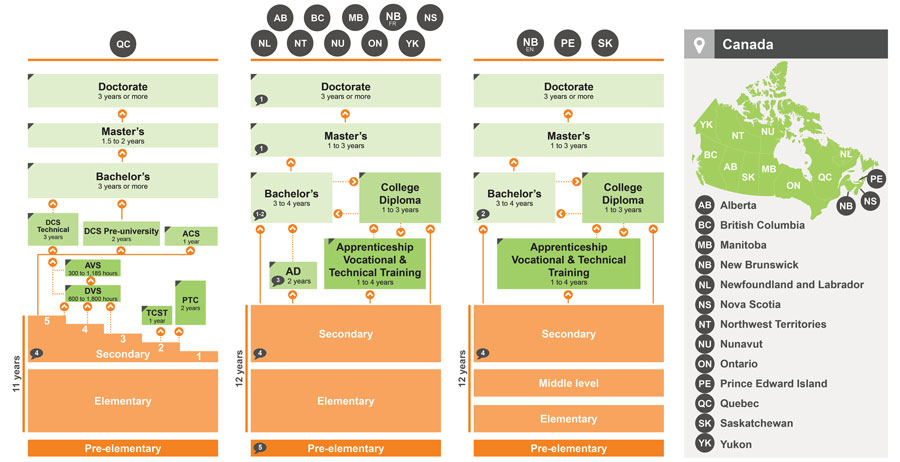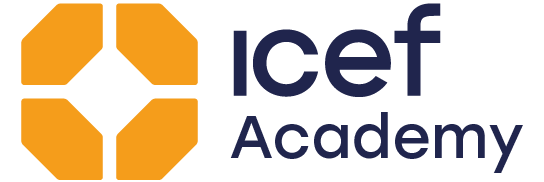C2. Levels of Education
The graphic below, produced by the Canadian Information Centre for International Credentials, shows which educational pathways are available to students in various regions of Canada.

All school boards/districts/divisions across Canada offer educational programs for children aged five to 17–18 years old. The levels range from Kindergarten to grade 11 (in Quebec) or grade 12. However, school structures and grade groupings vary throughout Canada’s provinces:
- Elementary schools instruct students from kindergarten or grade 1 to grade 4, 5, 6, 7, or 8.
- Middle schools typically enroll students in grades 5, 6, 7 and 8; however, the specific grades offered may vary by school and region.
- Junior high schools include grades 7, 8, and sometimes 9, offering a transition for students from elementary to high school.
- Secondary schools (frequently also referred to as high schools) begin with grade 8, 9, or 10 to 12, except for Quebec, where high school includes grades 7 to 11. Where offered, students may enroll in the International Baccalaureate Program or take Advanced Placement (AP) courses. It is also becoming increasingly popular for public schools to offer elite athletic and arts academy programs.
The typical school day includes five to six hours of class time, with the exception of kindergarten, which is half-day in some regions. The school year runs from September to June although some schools also offer a program year-round.
International students can expect to pay between $9,500 to $17,000 in tuition a year to study at the public elementary or secondary levels in Canada. Private or independent schools may have a higher tuition, particularly if they offer a low student–teacher ratio or enhanced/specialized learning opportunities. Tuition and boarding fees for K-12 private or independent schools in Canada, for example, ranges from $45,500 to $65,000.
Individual institutions establish their own admission policies and requirements for academic and language preparation. Once a student completes the graduation requirements in their last year of secondary school, they can apply for admission to a post-secondary institution. Students should verify the admission requirements, including language proficiency, of each post-secondary institution they wish to apply to.
Following secondary school completion, students have various options for study:
- They can choose from colleges, universities, or technical institutes.
- They can choose to take diploma or certificate courses, or full degree programs.
- They can begin in one program or type of post-secondary institution, and then transfer to another as their interests and goals evolve.
Canada is a well-educated nation at the post-secondary level. The proportion of Canadians aged 25 to 64 with a post-secondary degree or diploma is 54%, the highest in the OECD. Graduate degrees from Canadian universities, including masters and doctoral degrees, are highly regarded internationally and generally offer competitive tuition fees.
University and college semesters generally run as follows:
- First semester: early September to mid-December
- Holiday break: mid-December to early January
- Second semester: early January to early May
- Summer holidays/Summer courses: May to August
What Is a Study Pathway?
A study pathway is the study plan the student will follow—as it relates to the institution(s) and degree(s), diploma(s), and certificate(s) they will use to gain the credentials and experience required for their desired career.
It is the agent’s responsibility to advise students on which study pathways are available to them and what these pathways will result in when it comes to an ultimate degree or other credential.
A study pathway could include only one institution, degree and/or program, or it could include more than one, depending on the student’s ultimate goal and situation and what the institution(s) offer.
Traditionally, students wanting full degrees in Canada have begun their post-secondary studies at universities with undergraduate degrees—bachelor’s—that generally require three to four years when undertaken on a full-time basis. They could then choose, either immediately upon successful completion of their “undergrad” degree or after working for a period of time, to progress to graduate degrees—master’s and possibly then the highest level, doctoral—or to degrees in law or medicine (both of which require some level of prior undergraduate study), with admission contingent on high enough grades and/or other program-specific criteria.
While this traditional model is still followed by many students in Canada, there are now other study pathways and programs to choose from as a result of Canada’s quick adaptation to the changing skills demanded by a globalized, increasingly sophisticated labour market. For example:
- Certain colleges offer undergraduate degrees as well as practical degrees or diplomas.
- It is now quite common for students to begin an undergraduate degree at a college, polytechnic institution and then finish it at a university depending on their program of interest (please see text box on University Transfer Programs).
- After graduating from a university program, it is becoming more common for students to complement their university degree by pursuing a separate college degree or diploma.
While at first glance, this may sound confusing, there’s a better way of looking at it: there is now a great deal of flexibility within the Canadian post-secondary system, with colleges, polytechnics, and universities increasingly cooperating to give students the exact education they need for their chosen careers. Students can compose their own education, for example:
- They could choose to take a full degree from one institution (college, polytechnic, or university).
- They could choose to start their degree at one institution and then finish it at another (again, please see University Transfer Programs).
- They could complete a full degree at one institution then add on to it with a diploma or certificate from another institution designed to give them more specific and/or practical skills.
- They could choose to take a diploma or certificate (or several, depending on the skills they wanted and requirements of their desired job) rather than a degree.
Program searches should therefore include a broad range of institutions to ensure all possibilities are covered. It will be important to speak with specific institutions of interest to see what kind of study pathways are available to the student as they relate to the program of interest (e.g., opportunities for joint programs, co-operative education, internships, etc.) Co-operative education, or “co-op,” allows students to gain academic credit for hands-on work experience related to their program of study.
When conducting a program search, refer to the searchable database of Canadian study programs available on the EduCanada website.
University Transfer Programs
Many colleges and polytechnics have agreements with universities whereby certain courses are transferable and will be recognized by the university as counting toward a university degree.
These transfer programs are increasingly popular because they allow students to take the first one or two years of a typical four-year university degree at a college, before transferring to complete the final two years of the degree at university.
Why would a student want to do that? Colleges often offer smaller class sizes, greater access to instructors, competitive tuition fees, and a more personal atmosphere. This is very important for international students—many international students find beginning studies at a college to be a very comfortable, supportive option before they move on to a university, if a university degree is their goal. This way, they get the best of both worlds—the benefits of a college education and a university education.
University transfer programs across Canada include Business, Commerce, Journalism, Arts, Education, Engineering, Science, and Computer Science … and many more.
There are also some colleges and universities that offer joint diplomas and degrees, including agreements with other international institutions. The only way for agents to know about such arrangements is to find out directly from the institution/program, once they are very familiar with a college or university’s offerings.
Why Is the Flexibility in the Canadian Post-Secondary System Good for Students and Agents?
Simple: it’s about choice. Agents can provide students intending to study in Canada with a wide and exciting range of study pathways to choose from—they can help the student come up with a targeted plan that best suits their goals and situation. Post-secondary institutions in Canada will be more than happy to answer agents’ questions related to study pathways to ensure that students pick a course of study that will provide them with the education they need to be successful.
In the Canadian post-secondary system, students do not have to choose between an academic education and a practical, experience-based one. They can have both if they like thanks to the flexibility of the system and the cooperation not only of colleges, polytechnics, and universities but also of industry. In many programs of study, it is possible for students to do research or complete a co-op within the industry they wish to enter upon graduation. This is especially valuable for students seeking work in Canada after graduation and, possibly, to be permanent residents.
In addition, the Canadian system is flexible when it comes to students’ unique situations. Some students may have limited financial resources; others will need to improve their language skills; others still may need to upgrade their grades or pre-requisites to get into a program of choice, which, in certain cases, can be done through Canadian-based distance education programs before the student even steps foot in Canada. For all these circumstances and more, there are options within the Canadian system to help international students complete their desired study program.
